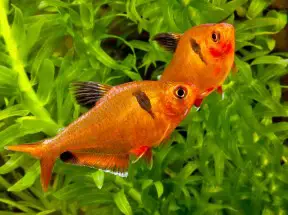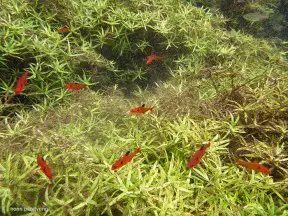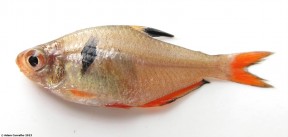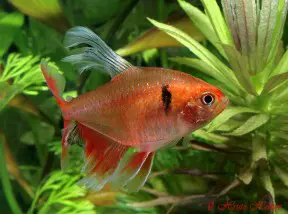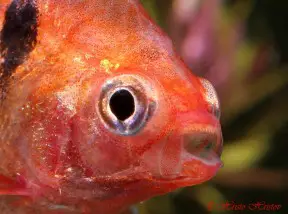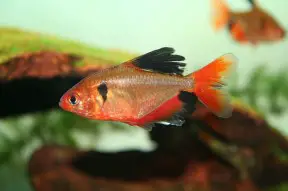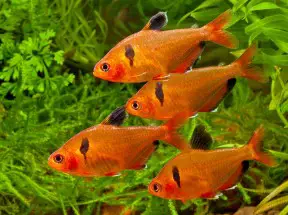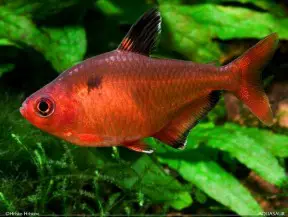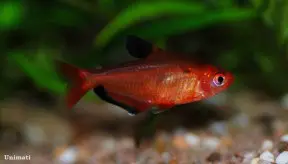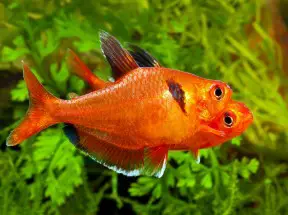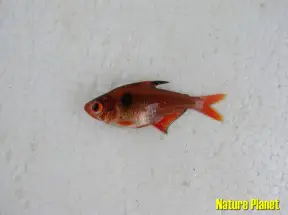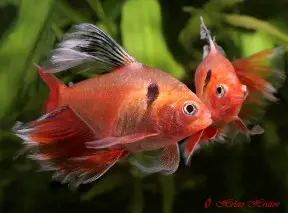Hyphessobrycon eques
Serpae Tetra
SynonymsTop ↑
Chirodon eques Steindachner, 1882; Cheirodon eques Steindachner, 1882; Tetragonopterus callistus Boulenger, 1900; Hyphessobrycon callistus (Boulenger, 1900); Hemigrammus melasopterus Eigenmann & Kennedy, 1903; Hyphessobrycon serpae Durbin, 1908
Etymology
Hyphessobrycon: from the Ancient Greek υπελάσσων (hyphesson), meaning ‘of lesser stature’, and used as a prefix in this case, plus the generic name Brycon.
eques: from the Latin eques, meaning ‘knight, horseman, rider’.
Classification
Order: Characiformes Family: Characidae
Distribution
As currently understood (see below) H. eques has an enormous distribution throughout much of the Amazon drainage in Brazil, Peru and Bolivia plus the Río Paraguay in Brazil, Paraguay and Argentina, the upper part of which is connected to the Amazon via the rio Guaporé.
Type locality is ‘Villa Bella, Obidos’, referring to the town of that name on the Amazon river in Pará state, Brazil, located between Santarém and Oriximiná.
Wild populations vary in colour pattern depending on origin, especially in the fins plus the size and shape of the humeral spot, and some populations have previously been described as species in their own right (see ‘Synonyms’),
It’s possible that some or all of these names might be restored in the future since only H. eques is valid at present.
It has been introduced in French Guiana via the aquarium trade.
Habitat
Most typically inhabits still and sluggish tributaries and backwaters, including ponds and small lakes, where it forms aggregations around patches of marginal vegetation or submerged tree roots.
Maximum Standard Length
30 – 40 mm.
Aquarium SizeTop ↑
An aquarium with base dimensions of 80 ∗ 30 cm or equivalent should be the absolute minimum considered.
Maintenance
Choice of decor is not especially critical although it tends to show better colouration when maintained in a well-furnished set-up with live plants and a dark substrate.
A natural-looking arrangement might consist of a soft, sandy substrate with wood roots and branches placed such a way that plenty of shady spots are formed.
The addition of dried leaf litter would further emphasise the biotope-style feel and with it the growth of beneficial microbe colonies as decomposition occurs.
These can provide a valuable secondary food source for fry, whilst the tannins and other chemicals released by the decaying leaves will aid in simulating natural conditions.
Leaves can be left in the tank to break down fully or removed and replaced every few weeks.
The vast majority of fish available in the aquarium trade are bred on a commercial basis and are more adaptable than wild specimens.
Water Conditions
Temperature: 20 – 28 °C
pH: The farm-raised fish available in stores are fairly adaptable where water chemistry is concerned and should be happy within the range 5.0 – 7.5. If you can get hold of wild stock slighty acidic to neutral water is advisable.
Hardness: 18 – 268 ppm
Diet
Likely to be omnivorous feeding on small invertebrates, crustacea, filamentous algae, fallen fruit and suchlike in nature.
In aquaria it may survive on a diet of dried foods but like most fishes does best when offered a varied menu which in this case should also contain live and frozen chironomid larvae (bloodworm), mosquito larvae, Daphnia, Moina, etc.
Behaviour and CompatibilityTop ↑
H. eques is notorious as an aggressive community inhabitant with a reputation for nipping the fins of tankmates although this behaviour tends to be most pronounced when insufficient numbers are purchased or space is limited.
It’s a gregarious species forming loose hierarchies, with rival males continually battling with each other for female attention and positioning within the group.
A group of at least 12 specimens should be considered the minimum requirement since this increases the likelihood that the fish will be distracted by each other rather than their tankmates but will result in a more effective, natural-looking display. A group of 12-15 in the minimum dimension tank given above with no other upper water species is advisable. Adding other compatible species requires larger tanks.
Males will also show better colouration in the presence of conspecific rivals.
That said it is relatively boisterous and doesn’t make an ideal companion for very shy, slow-moving, or long-finned fishes such as many livebearers, cichlids, and anabantoids.
Robust fishes inhabiting similar biotopes in nature, especially comparably-sized, open water-dwelling characids perhaps constitute the best choices but other potential options include gasteropelecids, lebiasinids, smaller callichthyid or loricariid catfishes and some small-to-medium-sized cichlids.
If geography is not an issue many rainbowfishes and cyprinids are also suitable, but be sure to research your choices thoroughly before purchase.
Sexual Dimorphism
Sexually mature females are noticeably rounder-bodied and a little larger than males.
Reproduction
An egg-scattering free spawner exhibiting no parental care.
When in good condition adults will spawn often and in a mature aquarium it’s possible that small numbers of fry may start to appear without intervention.
However if you want to maximise yield a more controlled approach is required.
The adult group can still be conditioned together but a smaller aquarium should also be set up and filled with mature water.
This should be very dimly lit and the base covered with some kind of mesh of a large enough grade so that the eggs can fall through but small enough so that the adults cannot reach them.
The widely available plastic ‘grass’-type matting can also be used and works well, as does a layer of glass marbles.
Alternatively filling much of the tank with a fine-leaved plant such as Taxiphyllum spp. or spawning mops can also return decent results.
The water itself should be of slightly acidic to neutral pH with a temperature towards the upper end of the range suggested above.
An air-powered sponge filter or air stone(s) should also be included to provide oxygenation and water movement.
When the adult fish are well-conditioned a single pair or group comprising one or two males and several females can then be introduced to each container and left in place until eggs are detected (typically the following morning).
Initial food should be Paramecium or a proprietary dry food of sufficiently small (5-50 micron) grade, introducing Artemia nauplii, microworm, etc., once the fry are large enough to accept them.
NotesTop ↑
This species is very common in the aquarium trade and is also referred to as ‘jewel’, ‘red minor’, ‘blood’, or ‘callistus’ tetra.
A number of selectively-bred ornamental strains have been developed, including ‘metallic’, ‘long-finned’, ‘balloon’ and ‘fairy-fin’.
Characiformes is among the most diverse orders of freshwater fishes currently including close to 2000 valid species distributed among 19 families.
This tremendous taxonomical and morphological diversity has historically impaired the ability of researchers to resolve their genetic relationships with many taxa remaining incertae sedis.
A further limiting factor has been that in many cases exhaustive study of these on an individual basis is the only way to resolve such problems.
Modern phylogenetic techniques have allowed some headway, though, and a molecular investigation of characiform relationships by Calcagnotto et al. published in 2005 revealed some interesting hypotheses.
Their results suggest that Hyphessobrycon is a member of a clade also containing the genera Astyanax, Astyanacinus, Moenkhausia, Inpaichthys, and Hemigrammus, of which all species possess five or more teeth in the inner series of the premaxilla.
A more extensive analysis by Oliveira et al. (2011) placed Hyphessobrycon in a much larger clade containing 29 genera including all those listed above.
This clade was one of three large clades, plus the genus Spintherobolus which was recovered as sister to all other characids, that formed the authors’ revised Characidae family.
Hyphessobrycon was raised by Durbin in Eigenmann (1908) as a subgenus of Hemigrammus, differing from the latter by the absence of scales on the caudal-fin.
The grouping was revised by Eigenmann (1918, 1921) while Géry (1977) created artificial groups of species based on pigmentation patterns, and these definitions are still widely used today, e.g., the H. aghula group, the H. heterohabdus group, etc.
Weitzman & Palmer (1997) hypothesised the existence of a monophyletic assemblage within the genus based on colour pattern and male fin morphology that they termed the ‘rosy tetra clade’.
They did not offer any hypotheses regarding relationships between the remaining species although Hyphessobrycon has long been recognised as a polyphyletic lineage and thus is likely to be split into several genera in the future.
De Carvalho (2011) redescribed H. compressus, type species of the genus, and conducted a molecular phylogeny incuding 227 taxa.
He concluded that Hyphessobrycon sensu stricto should be restricted to a monophyletic group of 24 species which share the unambiguous synapomorphy of the Weberian apparatus being orientated dorso-horizontally though the dorsal margin of the operculum with other defining characters comprising a black spot in the dorsal-fin and lack of visible lateral-line except in some specimens of H. pulchripinnis.
This group contains H. compressus, H. pulchripinnis, H. hasemani, H. haraldschultzi, H. troemneri, H. cf. troemneri, H. copelandi, H. takesei, H. minor, H. micropterus, H. rosaceus, H. megalopterus, H. bentosi, H. eques, H. sweglesi, H. werneri, H. epicharis, H. socolofi, H. pyrrhonotus, H. erythrostigma, H. khardinae, H. georgetta, H. roseus and H. simulans.
References
- Calcagnotto, D., S. A. Schaefer, and R. DeSalle, 2005 - Molecular Phylogenetics and Evolution 36(1): 135-153
Relationships among characiform fishes inferred from analysis of nuclear and mitochondrial gene sequences. - de Carvalho, F. R., 2011 - unpublished PHD Thesis: i-xxiii + 1-365
Sistemática de Hyphessobrycon Durbin, 1908 (Ostariophysi: Characidae). - Oliveira, C. A., G. S. Avellino, K. T. Abe, T. C. Mariguela, R. C. Benine, G. Orti, R. P. Vari, and R. M. Corrêa e Castro, 2011 - BMC Evolutionary Biology 11(1: 275-300
Phylogenetic relationships within the speciose family Characidae (Teleostei: Ostariophysi: Characiformes) based on multilocus analysis and extensive ingroup sampling. - Reis, R. E., S. O. Kullander and C. J. Ferraris, Jr. (eds), 2003 - EDIPUCRS, Porto Alegre: i-xi + 1-729
Check list of the freshwater fishes of South and Central America. CLOFFSCA. - Steindachner, F., 1882 - Anzeiger der Akademie der Wissenschaften in Wien, Mathematisch-Naturwissenschaftliche Classe v. 19 (no. 19): 175-180
Beiträge zur Kenntniss der Flussfische Südamerika's (IV).
